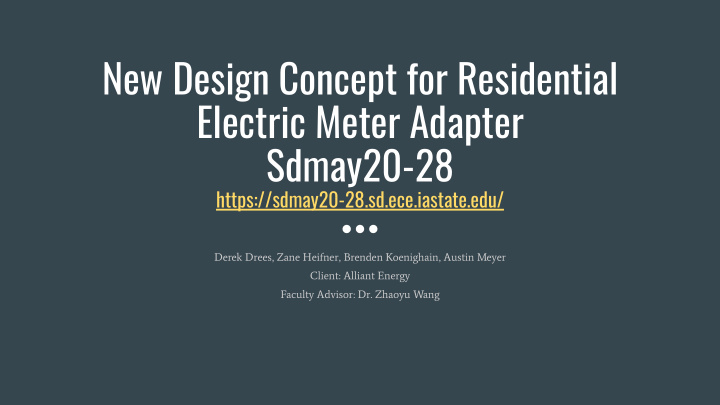



New Design Concept for Residential Electric Meter Adapter Sdmay20-28 https://sdmay20-28.sd.ece.iastate.edu/ Derek Drees, Zane Heifner, Brenden Koenighain, Austin Meyer Client: Alliant Energy Faculty Advisor: Dr. Zhaoyu Wang
Project Plan
Project Overview ● Alliant Energy, an energy provider, is converting from overhead distribution lines to underground. ● We were tasked with designing an adapter for residential electric meter sockets, that converts from existing overhead feeds to a new underground connection. ● The scope of our project was to create a design, 3D model, and prototype by the end of the year. https://www.portlandgeneral.com/outages/pow er-out/pge-certified-electrical-contractors
Problem Statement ● Alliant Energy’s current solutions to this problem Unsightly ○ Bulky ○ Expensive ○ Possible code violations/cause for ● inspection. Contractor involvement ●
Conceptual Sketch ● Will mount onto home and convert older overhead connections to underground feeds ● Prebuilt raceways across the top of our adaptor to connect old meter socket wires to new underground feeds ● Eliminates wire bend issue with the current solution
Requirements (Technical/Functional) ● Cannot result in a reinspection of the socket ○ This causes entire home to be required to be up to code ○ Will be on the homeowner’s responsibility to pay for this ● Must be able to match appropriate current ratings ● Terminal connections must be able to fit 1/0, 4/0, and 350 MCM wire to be universal for Alliant Energy ● Terminal connections must meet minimum distance of 1.5” from edge of enclosure ● Bus bar must be code compliant ● 1.5”, 2”, and 2.5” knockouts for conduit connectors
Constraints and Considerations Reduce cost ● Manufacturing ○ Installation ○ Aesthetically unobtrusive on house ● Biggest available wire is 350 MCM, so our project is designed to handle the ● maximum ampacity of a 350 MCM wire Enclosure modification ● Sized to contain all internal components ○ Knockouts to bring in conduit ○ Locking door ○
Potential Risks and Mitigation Plan ● Frequent feedback from Alliant Energy to fulfill the client’s criteria ● Contacted two seperate state inspectors on potential code violations and discussed potential solutions ● Had electrical contractors review different designs to foresee future installation issues ● Reviewed model and prototype design with turnkey panel manufacturing company to ensure proper and effective design
Resource/Cost Estimate Initial design concept cost estimated ~$2,500 per unit ● $2,000 for manufacturing parts and labor ○ $500 for installation ○ Up to $2,000 extra for code updates ○ Final design concept cost estimated ~$1,000 per unit ● ○ Buying in bulk will bring this price down ○ Labor cost will also be reduced by removing contractor labor
Project Milestones & Schedule
System Design
Functional Decomposition
Detailed Design : Bill of Materials
Detailed Design : 3D Model
Detailed Design : 3D Model
Detailed Design : Layout
Detailed Design : Layout
Detailed Design : Layout
HW/SW/Technology Platforms Used Software ● ○ AutoCAD Electrical - 2D layout AutoDesk Inventor - 3D model ○ ● Hardware Busbar rittal 3524.000 ○ Adapter rittal 9342.000 ○ Endcap rittal 9341.070 ○ Support rittal 9341.000 ○ Hoffman enclosure 24l x 12h x 6d ○
Test Plan ● **Testing cancelled due to COVID-19** ● Consistent feedback from Alliant Energy throughout design process. ● Designed using readily available code compliant parts. ● Prototype planned to be developed by a professional panel manufacturer. ● Installation timing comparison through industry professionals.
Prototype Implementations **Prototype manufacturing cancelled due to COVID-19** ● Initial model of our prototype has been approved for manufacturing. ● We have researched different part types to ensure code compliance. ●
Engineering Standards and Design Practices ● National Electric Code 2017: section 110.28 ● NFPA (National Fire Protection Association) ● Spoke with state inspectors ● Used stock parts from reputable source to ensure code compliance ● Feedback from industry professionals
Conclusion
Task Responsibility/Contributions of Each Project Member Derek Drees (Research) ● Research, communication with professionals/experts, brainstorming, verification. ○ Zane Heifner (Communication) ● ○ Communication/coordination between team, advisor, industry professionals, and client, drafting of 3D and 2D models Brenden Koenighain (Documentation) ● Made schedule and division of tasks, compiles and manages all documents, brainstorming, ○ creating an economic analysis of mass production of our design to evaluate cost effectiveness. Austin Meyer (Website and Testing) ● ○ Management of team website, producing weekly updates, brainstorming, verification, creating a testing plan to evaluate the ease of installation and therefore cost effectiveness of labor.
Future Prospect of the Project Next step is to manufacture a prototype ● First article build will provide more accurate mass production cost ● Design should be updated again after prototype build ● Future code updates could affect what specific parts were selected ●
Thank You
Recommend
More recommend